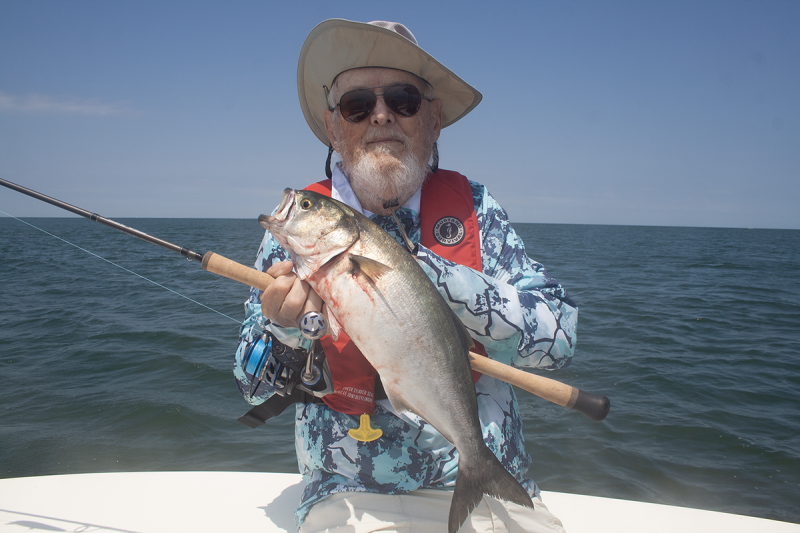A quick fishing trip in Virginia Beach
On June 16, I drove down to Virginia Beach to spend a couple of days with my son Ric and do a little fishing.
We were up early Monday morning and headed to the Chesapeake Bay Bridge-Tunnel after launching Ric’s 20-foot Jones Brothers center-console boat at Lynnhaven Inlet. The many pilings of the bridge-tunnel hold big sheepshead, and they would be our first target.
In order to fish for sheepshead at the pilings, you have to secure the boat to the piling. You do this by tossing a float from the boat to the up-current side of the piling, then drop back as the line from the float washes back in the current and snare it with a boat hook. Then you secure the line so you have a loop around the piling that holds the boat close enough to the structure so you can fish your fiddler crab on a jig tight to the piling without having the boat actually hit the rough surface. This is a job best left to the boat owner.
After fishing many pilings without so much as a nibble, I was beginning to fear my albatross had followed me to Virginia. A diver who was fishing alone, a dangerous undertaking in the strong currents around the bridge-tunnel, came by and reported only one sheepshead on any of the pilings and he shot it.
At that point, we gave up and moved on down toward the Third Island (islands are counted from the Virginia Beach side to the Cape Charles side).
As we approached the Third Island, we saw three boats that appeared to be anchored with their bows pointed toward the bridge. That made no sense, but as we got closer, we saw they were not anchored but simply pointing to the bridge while casting to big blues. We attempted to join in the fun, but by the time we got set up, the blues were gone. I am sure there were very uncomplimentary remarks sent our way from the other boats.
We moved around to the bayside of the Third Island, casting plugs to the rocks that line the island as we went. This is exactly what I did when I lived in Virginia Beach in the 1990s.
We had no action until we reached the area where the rocks meet the tunnel and begin to go underwater. Ric threw his popper in the smooth water in there and everything exploded with big blues. The birds waiting on the rocks went nuts, and my Wind-Cheater plug suffered a vicious attack. Ric got his fish in and released it while mine put on a dazzling air display that would put a tarpon to shame. I have caught a lot of blues in my life, but I have never caught one that jumped as many times and as high as this one. He cleared the water at least three or four times, and twisted and turned while he was in the air. What a fantastic fish to end my 2024 drought!
We stayed in the bayside pocket of the Third Island for as long as the blues wanted to play. Some we hooked and they got off. Some we got to the boat and we released. I kept two for my famous bluefish cakes. These were 10- or 12-pound blues, but they fought way above their weight class. I had one that took off and peeled line from my Tsunami EVICT 4000 with the drag set pretty tight and put a bend in my Tsunami Forged Heavy Action 7-foot rod. Since both rod and reel are brand new, these were the first fish they have caught.
On Tuesday, we started out even earlier, launched the boat at Rudee Inlet and headed offshore looking for sea bass and flounder.
Ric had several wrecks loaded in his GPS and we hit quite a few. Unfortunately, just like Delaware, the sea bass on all the wrecks inside 20 miles were small. And, just like Delaware, the wind came up and made it too rough to run the 30 miles or more offshore where the bigger sea bass live.
I was using a double bucktail rig with the larger 2-ounce leadhead on the bottom and a small jig on the top. Both were baited with green and orange Gulp! swim shads. I don’t know why, but every fish I caught, sea bass and flounder, were on the little jig on top.
As the day wore on, we began to catch fewer sea bass, but caught some flounder off the wrecks. I ended up with an 11- and a 21-inch flounder to finish my short vacation.
My hope now is the albatross is dead in Virginia and I can begin to catch some fish in Delaware.






















































